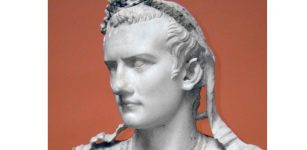Merovech – Legendary King Of The Franks And The Merovingian Dynasty
David Tee - AncientPages.com - History is not often kind. While some historical figures, like the Tudors, the Yorks, and Lancasters, have extensive information about them that survives the ravages of time. Others are not so lucky. Merovech remembered as the King of the Franks is one of those unlucky figures.
Silvered bronze mount of an armoire depicting the victory of Merovingian King Merovech over the armies of Attila the Hun in 451. By Emmanuel Fremiet, 1867. In the collection of the Metropolitan Museum of Art. Credit: Public domain, CC BY-SA 3.0
The ancient historians whose works are still extant today provide conflicting and sparse accounts of the man declared to be the long-haired King. Gregory of Tours, Fredegar, and Priscus rarely say much about this man who started the Merovingian Dynasty.
What Historians Have To Say About Merovech
Gregory of Tours was probably the cruelest of them all, placing Merovech as only the father of Childeric I. That’s it, and any accomplishments the father may have obtained were either ignored or non-existent.
Fredegar makes Merovech’s birth somewhat supernatural. He said Merovech’s existence was due to a union between his mother, the Queen, and Neptune, the water god. Finally, it is Priscus that provides the only accurate description of the man. He wrote that Merovech was young, fair-headed, and long-haired.
What doesn’t help is that Merovech’s reign may have been too short to amass the usual tributes that come from battles won, lands conquered, and so on. But it wasn’t until the 8th Century AD that the historian Francorum named Merovech his father’s successor to the throne.
How Vast Was The Kingdom Of Merovech?
Like Merovech’s life and birth, this is also up to dispute. Some historians claim that he was only a local chieftain who still had to endure the rule of the Roman Empire. Another event also related to Merovech is that Rome was not overthrown until about 20 years after Merovech’s death.
Merovech may not have been a great ruler of a great land, but even the greatest kingdoms had to start small. Rome was a mere city ruling over half of the known world.
Artist's impression of King Merovech, a bronze medal of Jean Dassier, 1720. National Library of France. Credit: Public Domain
One thing that did come from his reign is the symbol of his long hair. After Merovech, every King had long hair. Tradition had it that if the King’s hair were cut, he would lose his power. There is no indication if this is a myth inspired by the biblical account of Samson or if it had its independent origin.
Because no ancient document is surviving describing early Frankish rule, government, and Roman influence, it is hard to say how much territory and how many people Merovech ruled.
His Legendary Status
Because there is so little credible evidence about Merovech, his reign, and his kingdom, it is easy for legends and myths to exaggerate the man and his contribution to Frankish life.
One such tale comes from a more modern book, the Holy Blood and Holy Grail. This 1982 book speculated that Merovech had descended from a union between a fish and a human. This bloodline somehow is connected to the early Christian symbol of the fish.
The authors continued to speculate that Merovech was a direct descendant of Jesus, and his royal line spawned the Holy grail. The theory did not die down and was even more fueled when the book The Da Vinci Code was published.
These are not the only works that use this idea to drive the plots of the different authors’ works. Unfortunately for all of them, there is zero evidence to back their theory.
No one knows anything about Merovech, his life, his reign, and so on, leaving history vulnerable to all sorts of exceptional hypotheses that have no hope of being verified.
History becomes a tool for those needing to sell their works instead of a source for facts and truth.
Some Final Words
Merovech and his father, Clodio, are seen as semi-legendary because they may have been confirmed, or they may not have been actual people who ruled the Franks. The mystery fuels their reputation. But what is known to be true is that Merovech’s son and Clodio’s grandson was an actual ruler of the Franks.
Childeric I was a historical figure, and Gregory of Tours recorded his life events. The downfall of Childeric I was his very wild and extra-curricular lifestyle.
Written by – David Tee - AncientPages.com Staff Writer
Updated June 20, 2022
Copyright © AncientPages.com All rights reserved. This material may not be published, broadcast, rewritten or redistributed in whole or part without the express written permission of AncientPages.com
Expand for referencesMore From Ancient Pages
-
 “Thogcha” – Thousand-Year-Old Tibetan Amulets And The Bon Culture
Ancient Technology | Dec 11, 2021
“Thogcha” – Thousand-Year-Old Tibetan Amulets And The Bon Culture
Ancient Technology | Dec 11, 2021 -
 Preserve Elfdalian: Sweden’s Secret Forest Language From The Viking Era
Civilizations | May 21, 2015
Preserve Elfdalian: Sweden’s Secret Forest Language From The Viking Era
Civilizations | May 21, 2015 -
 Visit The Palace Where Alexander The Great Was Born In Pella
Archaeology | Oct 21, 2020
Visit The Palace Where Alexander The Great Was Born In Pella
Archaeology | Oct 21, 2020 -
 On This Day In History: Roman Emperor Caligula Was Born – On August 31, 12 AD
News | Aug 31, 2016
On This Day In History: Roman Emperor Caligula Was Born – On August 31, 12 AD
News | Aug 31, 2016 -
 2,000-Year-Old Completely Preserved Shipwreck With Amphorae Found Near Šćedro Island
Archaeology | May 14, 2024
2,000-Year-Old Completely Preserved Shipwreck With Amphorae Found Near Šćedro Island
Archaeology | May 14, 2024 -
 Unusual Medieval Knife Used Like An Eraser Discovered In Poland
Archaeology | Feb 16, 2018
Unusual Medieval Knife Used Like An Eraser Discovered In Poland
Archaeology | Feb 16, 2018 -
 Mystery Of 3,000-Year-Old African Civilization Garamantes And Its Ancient Secrets
Archaeology | Feb 16, 2015
Mystery Of 3,000-Year-Old African Civilization Garamantes And Its Ancient Secrets
Archaeology | Feb 16, 2015 -
 Burial Of Queen Of Emma Of Normandy Discovered In Winchester Castle
Archaeology | Nov 2, 2021
Burial Of Queen Of Emma Of Normandy Discovered In Winchester Castle
Archaeology | Nov 2, 2021 -
 Neanderthals Hunted Dangerous Cave Lions In Eurasia – New Study Shows
Archaeology | Oct 12, 2023
Neanderthals Hunted Dangerous Cave Lions In Eurasia – New Study Shows
Archaeology | Oct 12, 2023 -
 Pacific God A’a: Fascinating Polynesian Sculpture Designed To Carry A Human Skull And Bones
Archaeology | Apr 9, 2016
Pacific God A’a: Fascinating Polynesian Sculpture Designed To Carry A Human Skull And Bones
Archaeology | Apr 9, 2016 -
 Were Owl-Shaped Plaques Children’s Toys In Copper Age?
Archaeology | Dec 1, 2022
Were Owl-Shaped Plaques Children’s Toys In Copper Age?
Archaeology | Dec 1, 2022 -
 Unique Balchiria Stelae Engraved With A Goat-Like Figure Found On Corsica Is A Puzzle
Featured Stories | Feb 3, 2020
Unique Balchiria Stelae Engraved With A Goat-Like Figure Found On Corsica Is A Puzzle
Featured Stories | Feb 3, 2020 -
 Isabel Neville And Unsolved Mystery Of Her Death
Featured Stories | Mar 28, 2019
Isabel Neville And Unsolved Mystery Of Her Death
Featured Stories | Mar 28, 2019 -
 Traces Of An Unknown Ancient Race Of Winged Beings And Other Mysterious Creatures Discovered In Japan
Civilizations | Nov 30, 2018
Traces Of An Unknown Ancient Race Of Winged Beings And Other Mysterious Creatures Discovered In Japan
Civilizations | Nov 30, 2018 -
 Riddle Of Brazilian Atlantis – Strange Discovered Rocks The World Forgot About
Featured Stories | Jan 28, 2022
Riddle Of Brazilian Atlantis – Strange Discovered Rocks The World Forgot About
Featured Stories | Jan 28, 2022 -
 Legendary Basilisk With Deadly Petrifying Stare – King Of The Serpents
Featured Stories | Dec 27, 2021
Legendary Basilisk With Deadly Petrifying Stare – King Of The Serpents
Featured Stories | Dec 27, 2021 -
 Irish God Ogma – Outstanding Warrior And Inventor Of The Ogham Script
Myths & Legends | Jul 3, 2024
Irish God Ogma – Outstanding Warrior And Inventor Of The Ogham Script
Myths & Legends | Jul 3, 2024 -
 King Henry VIII’s Walking Staff And Other Unusual Weapons
Artifacts | Nov 1, 2017
King Henry VIII’s Walking Staff And Other Unusual Weapons
Artifacts | Nov 1, 2017 -
 2,000-Year-Old Stringed Instrument Found In Vietnam
Archaeology | Feb 22, 2023
2,000-Year-Old Stringed Instrument Found In Vietnam
Archaeology | Feb 22, 2023 -
 Old Norse Settlers Traded Walrus Ivory With Kyiv – Spectacular Archaeological Finds Reveal
Archaeology | Jun 16, 2022
Old Norse Settlers Traded Walrus Ivory With Kyiv – Spectacular Archaeological Finds Reveal
Archaeology | Jun 16, 2022


